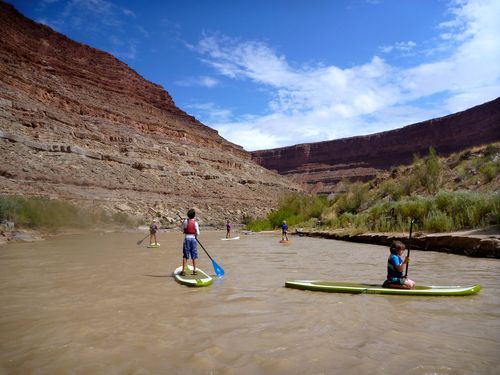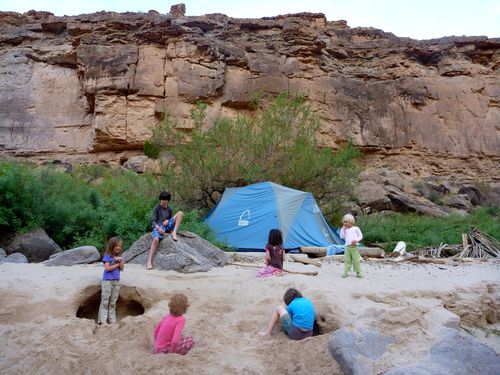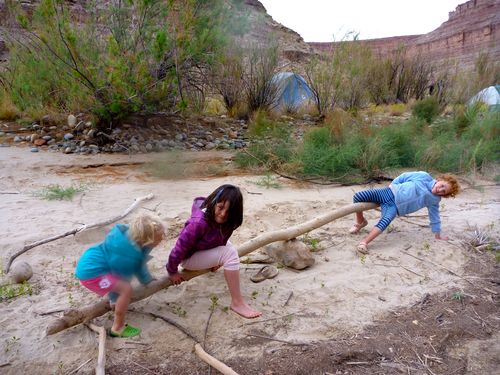
�������������������������������������������� ��What's SUP San Juan?
It always takes a little while to get into the flow of a river trip, but I know I’m there when, on a recent Saturday night in early September, I find myself sitting on a sandbar, margarita in hand, watching the setting sun bathe the canyon rim in tangerine and cantaloupe. The kids are so busy burrowing in the sand, they’ve forgotten we are here and—almost—vice versa. There are 10 of them, not counting the baby (who has very agreeably gone to bed for the night), ages 3 to 13, and—by now, three days in—they’ve morphed into a single, self-contained, sand-encrusted, mud-streaked unit, with its own language and pecking order and collective schemes. It’s Lord of the Flies, San Juan Edition.��
Tonight, the mission seems to be: Dig Elaborate Tunnels in the Sand or maybe Reenact the Chile Mining Disaster. So far the only casualty is a plastic lobster beach shovel, now cracked beyond repair. In the settling dusk, the children are becoming less distinct and more shadowy, and I can just make out our three-year-old’s blonde head, hunched over the slope. The older kids have donned headlamps and, from this distance, resemble miniature miners toiling at their passageways. Sooner or later it will be bedtime, but for now, nothing whatsoever needs to be done except kick back, pour another cup of box wine, and watch them work. ��
We’re camped on a sandbar just below Eight Foot Rapid, river left, at roughly mile 18 on the upper San Juan River. Together with four other families from Santa Fe and Durango, we put-on two days ago in Bluff, Utah, and by the time we take out tomorrow at Mexican Hat, we’ll have floated 27 miles, three rapids, and countless riffles through a deep crack in the desert. Our flotilla consists of three rafts, two duckies, and five standup paddleboards, though the distinctions of who brought which boat and who rides in which craft have become irrelevant. We’re not so much paddling as playing musical boats. Lured by Tootsie Pops and Pringles, our three-year-old parked herself in our friend Will’s raft with the other kids and wouldn’t budge all day.
That’s one of the perks of boating with a bunch of families: pawning your kids off on other people. Another: waking up to breakfast quesadillas and coffee that someone else made. Gliding in rare silence on a paddleboard while another mother minds the baby on your boat. Extra hands to set up the pop-up shade (and dismantle it at three A.M. when a storm rolls in). Laughing your ass off around the campfire while your dentist friend tells a story about stealing a canister of nitrous oxide during grad school and an almost full moon heaves itself above the canyon rim. Watching the kids go feral and bury themselves waist deep in river mud, and knowing that there are 9 parents to help dig them out.
River trips are like measuring sticks: When you’re caught up in the daily hustle, it’s easy to overlook how quickly your kids are growing, how fast time chugs by, how nothing stays the same, even for a minute. Spend a few lazy days on a river without deadlines or schedules or playdates or Playstations—where your only job is to keep the kids fed and safe, to make and break camp, and let the river carry you downstream—and you’ll come away with a new perspective on how crazy-busy our everyday lives are. Reduced to its simplest form, life on a wilderness river slows to a hypnotic crawl; the river sets the pace and encourages creative play—in all of us. If only we could live like this all year.��
Three months ago, we floated the lower San Juan, and it was an entirely different trip: Sunnier, hotter, longer, faster, less stressful in some ways, and more stressful in others. Maisy wasn’t walking yet and was content snoozing in her car seat; now she’s wriggly and desperate to roam and would walk straight into the muddy river, and keep walking, if we let her. The San Juan was flowing ten times higher than it is now—6,000 cubic feet per second, compared to 600—and Pippa, not quite 3, required constant, vigilant hovering to make sure she didn’t wind up in the water and get swept downstream to Lake Powell in a blink. Three months later, she’s more reliably aware that the river’s edge is a boundary she mustn’t cross without an adult, less interested in hanging out with us, and more interested in riding a backcountry teeter-totter and digging caves with the other kids. She’s part of a posse now. So this is how it happens, I think, watching her log-roll down a sand dune in her pajamas in the dark: This is how kids grow and are gone, right before your eyes.��

The next day, our last, brings us to Ledges, a Class II rapid and the final whitewater of the trip. Rob’s scouted the run—enter on river right and then paddle to river left to avoid the ledgy wall—and everyone clears but Paul, who’s upright on his SUP until he biffs in a hole. Afterwards, we regroup on a beach just below, strip down to our bathing suits, and turn the muck at the water’s edge into a giant, muddy slip-n-slide (note to self: arch your back before impact unless you want to land on your nose so hard it feels like you broke it). This is the best beach we’ve seen in four days, broad and�� where the river makes a long sweep to the right—a sweet place to camp—and it’s no hardship to stretch out in the sun while a couple of the mothers and 13-year-old Ariel walk the paddleboards upstream and try to run the rapid standing up.��
Bringing a stash of paddle boards has turned out to be the most ingenious idea of the whole trip. Our friends’ inflatable and boards are stable enough for seven-year-olds to paddle solo through Class I riffles and our friend Amy to rock a headstand on while drifting backwards downstream. Twelve-year-old Oslo paddled his standing up almost the whole way through Ledges, until evasive action was needed to avoid the hole on river right. Watching these little river rats, who have been paddleboarding the Animas through Durango all summer, is an impressive sight. When they get tired, they just plop down on their butts or knees and keep paddling.��

I’ve had my respite on a SUP and am already picturing three-year-old Pippa paddling her own next year when we round a last bend and see the gravelly beach of the boat launch at Mexican Hat. It’s taken us all day to go ten miles, but no one’s in a hurry to take out. “Mama,” Pippa calls to me from her perch atop Rob’s raft, “I want to go again!” Everyone’s sentiments exactly.��
If You Go:
Flowing west along the Colorado Plateau in southeastern Utah, the San Juan is one of the most family-friendly in the West, ideal for DIY boaters. You need a to raft it; the deadline for the lottery is February 1st. The boating season runs from April through October, with high water in June. By September, the lower section is too low to run without having to drag your boats over sand bars on the last day above Lake Powell. Operative word: Drag. In the fall, opt for the upper instead.��
At 27 miles, the Upper Section from Bluff to Mexican Hat can be run in as little as two nights, but with a big group like ours, setting up and breaking down camp each day takes longer, so you’ll want to budget more time. We launched alongside a group of three that was spending a leisurely five nights between Bluff and Mexican Hat. More time on the river is always a good thing! The upper section’s highlights include the 1,000-year-old Native American ruins at River House—think micro Mesa Verde—and extensive petroglyphs at Butler Wash, while the lower has longer hikes, including Slick Horn Canyon and Oljeto Wash.��
From Mexican Hat to the takeout at Clay Hills, it’s 58 miles through the winding Goosenecks and remote canyons of the Lower San Juan. With kids, plan on four nights minimum, five if you want a layover day. Government Rapid is the one Class III on the whole stretch and definitely worth scouting. There’s a clear path on river left if you want to walk the little ones around. You’ll want seven or eight days to run both sections at once—definitely on our bucket list for next year.��
If you didn’t score a permit or would rather go with a guide, outfitters like and run trips on the upper and lower, though there’s usually a minimum age requirement of four or five. ��
Pre- or post-trip, let the kids crash out in an air-conditioned room at the in Bluff, while you sit outside on the veranda drinking beers in the desert night. Just across the street, the justifiably popular sells out of cinnamon rolls, homemade granola, and fluffy blue-corn pancakes by 10 AM. Go early and browse their cache of used books and locally-made jewelry while you wait. Down the road in Mexican Hat, the sits on a cliff with river views, and the , at the Mexican Hat Lodge,��is the place for chicken, steaks, or burgers cooked cowboy-style over an open flame, and live music if you’re lucky.��
Check out the for info on vehicle shuttles. It’s 19 road miles from Bluff to Mexican Hat, so it was no big deal to shuttle our own cars to the take out, but you’ll definitely want to hire a driver if you’re rafting from Mexican Hat to Sand Island. Pick up a copy of the waterproof before you go.��
��—Katie Arnold��
��